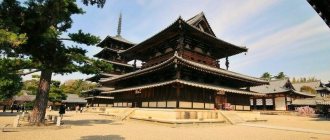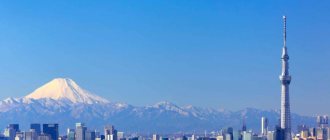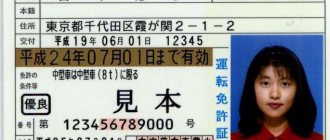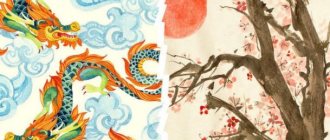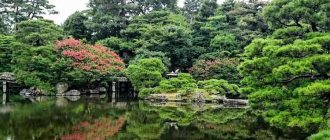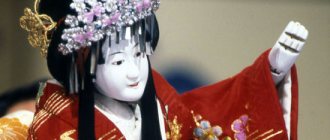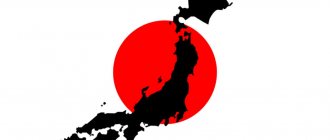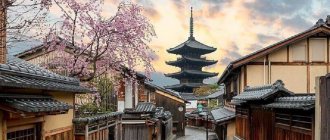The country of Japan is called the land of the rising sun. The sun in the center of the flag means the flourishing of the state and its perfection. This is a symbol of light, wealth, abundance. There is no doubt!
It is at this level of development that the land of the rising sun has been for many centuries. Admiration for Japan is possible only through knowledge of it, understanding of its traditions, penetration into its deep secrets.
In this island country, ancient samurai traditions and modern technologies are intertwined: in essence, the country has been living in the 22nd century for a long time. Japan has the highest life expectancy at 82 years and the lowest infant mortality rate.
Japan on the world map
Japan - view larger map
Japan is located on almost 7,000 large and small islands, which are washed by the Pacific Ocean, East China, Japan, Aki and Okhotsk seas. 97% of the country's total area is occupied by the four largest islands: Honshu, Hokkaido, Shikoku and Kyushu.
Japan on the world map
Japan got its name from the ancient Japanese “Yamata”, which translated means “country of mountain people”. The total area of this island state is 377835 km2.
Japan's northern borders separate it from Russia (Sakhalin, the Kuril Islands), its southern borders from the Philippines, and its western and northwestern borders from China and South Korea.
More than 127 million people live on the islands, of which 99% are Japanese. Another 0.5% each accounts for the Koreans and Chinese with the Ainu (remnants of the indigenous population). Almost all residents speak Japanese, which is the official language.
The form of government of the state is a constitutional monarchy, and its head is the emperor, who has no real power. It is rather a symbol of the unity of the nation.
Religions in Japan: Buddhism, Shinto, Christianity. In general, the Japanese are very warm towards any religion, and never interfere with anyone’s communication with their gods, of course, provided that your prayer does not disturb the peace and comfort of those around you.
Country Japan - tips for the journey
Guide: I highly recommend Lonely planet - all addresses, phone numbers, hotels, restaurants, museums, prices, routes and maps are listed in detail.
Currency: yen.
Souvenirs: Asakusa sells an endless supply of keychains (about $5), fans, summer umbrellas, cards and rice paper. All department stores have a floor of national clothing. Buy Yukata - homemade kimono ($30-35).
Excursions: walk on a river bus. The Sumida River flows through the center of the city. The final stop is the Asakusa shopping district.
National flag of Japan - Sunny
The flag of Japan is simple, and, probably, that’s why it’s very memorable: a red circle, representing the rising sun, in the center of a white cloth.
According to ancient legend, the flag tradition dates back to the Mongol invasion of the country in the 13th century. Buddhist monks presented it as a gift to the Japanese emperor, as a direct descendant of the Sun Goddess.
"Nisshoki" - "sun flag" - is the official name of the state standard. But a more common option is “Hinomaru” - “sun disk”.
“Hinomaru” received its state status after 1868, during the era of national restoration.
The flag is a real shrine for any Japanese. Just like the Emperor.
What to see in Japan?
Ogasawara is one of the smallest national parks in Japan. You should walk around Ginza at least once. It is not that big and in some ways (with its tall buildings and crowds of pedestrians) it resembles New York.
Multi-storey stores are very popular in Japan: “Maruya”, “Matsusakaya”, “Sei-bu”. A girl in a hat and gloves stands in the elevator and calls out the floors in a pleasant voice. Get off on the penultimate floor - there are sales going on there. If you like shabu-shabu (a dish made from the meat of a marbled cow), then the best restaurant, although expensive, is waiting for you at the New Otani Hotel.
I like the Japanese isakai pubs the most. It's noisy there, there's life there. And eat good sushi, in Japan they are the best in the world, that’s for sure. It's interesting to visit sumo. You won't see anything like this anywhere.
For example, they watch sumo while sitting on cushions. You buy a compartment (it has four pillows), sit for yourself, drink and eat with friends, watch the fight. Sheer delight!
Visit the ancient Nihombashi Bridge. There is a metal plate embedded in the center of the bridge. This is the point from which distances in the country are counted. Go to the Tokyo Imperial Palace. It opens its doors twice a year (December 23 and January 2). On other days the palace is closed to visitors.
Climate of Japan - summer is like summer, winter is like winter
The climate in Japan varies depending on the latitude in which a particular territorial area is located. The northern part is characterized by moderation, the southern part is characterized by subtropics and monsoon tropics.
Sufficiently hot summers throughout the country cause the thermometer to rise from +30°C to +38°C. At the same time of year, air humidity is very high here, because... maximum precipitation occurs. Hurricanes and typhoons are common. Temperatures in winter range from -5°C to -15°C, on the Ryukyu Archipelago – up to + 16°C. At the same time, quite a lot of snow falls.
Hot and humid summers contribute to the diversity of the plant world. The country's flora is represented by more than 17 thousand plant species, the most famous of which is sakura - the national symbol of the Japanese. Many tourists specifically buy event tours to watch the cherry blossoms.
The fantastically beautiful annual (in April) flower festivals here are dedicated to the seasonal multicolor and riot of colors.
September is the logical start of autumn with mild temperatures and acceptable precipitation.
Planet Japan
Exciting and varied tours to Japan turn a holiday in this country into an unforgettable adventure. Any Asian country is exotic. But a trip to the Land of the Rising Sun can only be compared with a trip to another planet))))) it is so original and unique. I propose a film from the Golden Globe series about Japan.
— —
The Japanese carefully and reverently preserve their identity, not allowing outside influences to penetrate their national culture. This country harmoniously and wisely combines ancient traditions and the heritage of its ancestors with the highest achievements in economics and production. The simplest example is the classic theater of the Land of the Rising Sun.
Japan is rightfully considered the healthiest country on the planet. Many healing and rejuvenating techniques originated from here. There are many healing hot springs in the country, where a full range of health services are provided. Even 70-80 year olds enjoy going on the best holiday - to the national onsen baths.
Those who are planning an active holiday here should consider Fuji, where they can go paragliding or try to conquer Asso, a volcano with the world’s highest caldera.
Skiers can go to the resorts of the island. Hokkaido, and divers - on the coast of the island. Okinawa.
For tourists interested in history and culture, I can suggest Kyoto. And to everyone, without exception, Tokyo is the capital of Japan, where centuries-old traditions and modernity merge together.
A favorite place for tourists who come here is the White Heron Castle, one of the main cultural and historical attractions of the country. The castle is represented by a temple complex surrounded by a labyrinth garden.
Museums in Japan are, for the most part, treasuries located in temples and holy places. Among them: Miyohon Temple, Meiji Treasury Museum, etc. In addition to them, it is worth seeing:
- National Museum and Museum of Calligraphy;
- Museum of Japanese Folk Art and National Museum of Western Art;
- National Science Museum and Art Museum.
In general, the Land of the Rising Sun has a rich history shrouded in many secrets and legends, which the Japanese do not share with every foreigner. But how much secret knowledge the ancient Japanese possessed... No one can even say approximately how much they actually knew. I offer you an interesting film on the topic of ancient knowledge in Japan.
—
—
Here are a few more facets of this mysterious and beautiful country.
Interesting from the point of view of history and architecture are:
- Imperial Palace in Tokyo;
- many beautiful cities, including Ibusuki, Nara, Hiroshima, Osaka;
- Buddhist temples, the main one among which is Rakanji;
- capital television tower, the height of which is 333 m;
- Nijo Castle;
- Katsura Palace;
- Nagoya Castle;
- ancient tombs of the imperial dynasty;
- Asakusa Kannon, Atsuta and Isha temples are the oldest Shinto shrines;
- beautifully maintained gardens, parks, etc.
In the city of Yokohama you will get acquainted with modern Japan, its skyscrapers propped up by clouds and the achievements of scientific and technological progress.
The beaches on the islands are undoubtedly also at the highest level. But visiting this country is unthinkable without combining a seaside holiday with getting to know the local culture and attractions.
State name
Why Japan is the Land of the Rising Sun? To answer this question, we should turn to the origin of the name of the state. The word "Japan", as we call it, is an exonym and comes from German. The residents themselves refer to their homeland as “Nihon” or “Nippon”. Both the first and second options are written using “kanji”. "Nippon" is a more formal name. It is usually used on postage stamps, yen, and in the names of any events of national importance. In everyday life, “Nihon” is most often used.
The Japanese call themselves “Nihonjin”, the language they speak is “Nihongo”. The official name of the state is “Nippon Koku” or “Nihon Koku”. The latter option literally translates as “homeland/source of the Sun.” This name first appeared in correspondence between the Emperor and representatives of the Sui (Chinese dynasty). "Nihon" is often translated as "Land of the Rising Sun." This name began to be actively used approximately from the Nara period. Until that moment, the state was called “Yamato”.
Mount Fuji (Fuji) is as much a symbol of Japan as the rising sun.
The graceful cone of Japan's tallest mountain has long evoked a deep sense of worship
Mount Fuji (Fuji) is as much a symbol of Japan as the rising sun. Its regular cone rises lonely over the plains of the Pacific coast of the island of Honshu. Through the efforts of countless artists and photographers, Fuji's distinctive silhouette has become known throughout the world. Only poets who saw Fuji for the first time can convey its magnificence in words.
The charm of Fuji lies not only in the elegance of its outlines. The appearance of the mountain is endlessly changeable: the light and mood of the landscape change, the snow cover increases and decreases, and clouds often appear to cover the peak. The beauty and perfection of Fuji are enhanced by slight imperfections in perfect shape. The profiles of its slopes are slightly different, and they do not converge at one point, and the top of the mountain seems to be jagged.
Cold top. Zigzag trails lead to the summit of Mount Fuji, a volcanic crater covered in snow most of the year.
The summit is the edge of the crater. Mount Fuji, 3776 m high, is a volcano. It was the constant emissions of lava and ash that formed this mass, the circumference of which is 125 km. The first written evidence of an eruption dates back to 800 BC. Since then, the volcano has awakened several times. The last eruption occurred in 1707; then black ash fell even on the streets of Tokyo, located 96 km from Fuji.
The Japanese often call Fujiyama Fuji-san, this is how they address a particularly respected person. The descendants of the ancient Ainu population of Japan consider the mountain sacred. Perhaps its name comes from the Ainu word meaning "fire" (sounds something like "fuchi"). Fuji is also sacred to followers of Shintoism, which is based on the cult of nature deities and ancestors, and to Buddhists. There is a religious sect dedicated to the mountain, the Fuji-ko (Fuji Society). Founded back in 1558, it still has many adherents today.
Tourists and pilgrims climb through forests where pines and larches grow, and cherry trees and azaleas bloom in spring, to windswept slopes where only the shortest shrubs survive. The climb is quite difficult, the weather can quickly turn bad, and closer to the top it gets colder: even in August the temperature is only about 6C.
At the last stage of the journey, the paths wind along slopes covered with a scattering of boulders. Along the edge of the crater, eight peaks rise in the shape of an irregular circle, which are called the “eight petals of Fuji”, they give the peak a characteristic jagged outline. The crater, 700 m across, is called Nai-in (Sanctuary) and is also an object of worship.
Down the slope. The descent from the top of Mount Fuji can be accelerated by sliding down the slope.
Buddhist artists often depicted Fuji with Lake Kawaguchi, in the calm waters of which the mountain is reflected, as in a mirror. In the wooded surroundings of Fuji there are four more lakes and many streams with waterfalls.
Every year, at least 250,000 tourists climb Mount Fuji. The mountain is a place of pilgrimage, at least for men: women were not allowed to climb Fuji until 1868. Each pilgrim carried a stone with him, i.e. made a symbolic path of liberation from the burden of the sinful world remaining at the foot of the mountain.
Fireworks on Fuji...
Fuji's snow edge rises and falls
Many tourists make the long trek to the top at night in order to reach it by the time the sun rises. In the last minutes of a cold summer night, the sun, which has not yet appeared, colors the sky with purple, copper and red reflections. With sunrise, an unforgettable panorama of lakes, forests and the distant coast opens before the eyes of travelers. The sun illuminates the shrine of Japan - Mount Fuji, and it seems to grow out of the darkness like a huge triangle.
In pink tones. The rising sun illuminates the divinely beautiful outlines of Fuji.
Fuji in art
Picturesque images of Fuji appeared in the Middle Ages. Later, Japanese masters of color woodcuts Suzuki Harunobu (1725–1770) and Katsushika Hokusai (1760–1849) included it in their compositions.
The legendary Fuji often served as the backdrop for scenes with graceful female figures, typical of Harunobu. In the landscapes in Hokusai's prints, Mount appeared as a symbol of purity and beauty.
With Fuji in the background. Fuji appears in the background of Harunobu's Girls with Salt and Hokusai's The Great Wave off Kanagawa.
Save the material to your bookmarks so you don’t lose it later!
5 1 vote
Article rating

